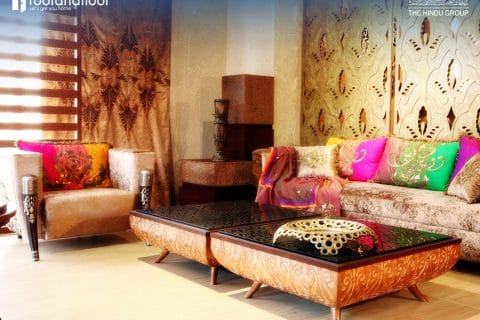Homes are an aspect that humans have taken great pride in since time immemorial. From the carefully thought out and constructed large family homes of the ancestors to the compact spaces inhibited by nuclear families today, everyone has a soft corner for their homes. No wonder then that so much care is taken in constructing and decorating them.
The Bunt community of Karnataka called their traditional homes Guthu Mane meaning home of prestige. The houses were constructed with great attention to detail and fit the requirements of the matrilineal joint families that lived in them.
Guthu mane was generally built in the centre of the land holdings that each family owned. The architecture of these homes followed Vastushilpa principles. The homes themselves were preceded by paddy fields called bakimar kanda. Once past the paddy field, one came upon the tudame or main gate which was made from bamboo poles that were made to slide into holes in wooden posts on the opposite side.
The open space in front of the house beyond the main gate was called jaal. In one section of this space, there was shade made from woven dried coconut leaves referred to as madal da dompa. They were meant to act as protection from extreme heat. In another part of the jaal, a flat stone slab called ‘kall chapadi’ and a rock-cut container for the water called ‘kalla marai’ was kept so that visitors may wash their feet before entering the home.
Mogasale was the sit-out of the house. The main door, or hebbagilu, was made from intricately carved teakwood or rosewood. Beyond the door was an open yard or angala which was covered on all four sides by carved walls. Then there was the assembly space or chavadi where the head of the family met with tenants or villagers. One step below the chavadi, a long verandah served as space for common folk to sit.
The chavadi itself featured exquisitely carved wooden pillars referred to as ‘khambas’. The pillars upheld the muchige a decorated wooden ceiling which usually had representations of mango and floral designs, foliage and coin motifs. Solid wooden beams called jantis supported this grand ceiling.
Past the chavadi, one could find the central portion of the home – the padsale. This space was reserved for the ladies of the house and was not accessible by non-bunts. The door to the area, aya da bakil, was often made from the wood of the jackfruit tree. Intricately detailed designs adorned these doors. A niche above the door held the keys to the house. Wrought iron treasuries containing family heirlooms were commonplace here.
The homes also featured deverna kone or rooms dedicated to worshipping deities. The bandasale served as the in-house granaries. The first floor or malige was accessed by a flight of stairs and led to spacious bedrooms. The kitchen, referred to as adpil was usually found in the southeast corner of the house. Attics above the kitchen housed large quantities of rice grains and had a chimney that let out smoke emanating from the kitchen below. The brilliance of this design is that the smoke was allowed to percolate in the attic before letting it out which ensured that pests stayed away from the grains.
The back door to the house was called kuru bakil. Guthu mane typically featured a lot of woodwork. Wooden swings where the head of the house sat, chests, cabinets, shelves, chairs, writing desks, reclining chairs and the quintessential vakil bench were all part of these homes. They all featured beautifully intricate carvings which were sometimes inlaid with ivory.
Materials included in the construction of the guthu mane roofs included Mangalore roofing tiles, terracotta tiles and glass tiles to let in light. Availability of wood and skilled labour allowed these rich landlords to adorn their homes with exquisite woodwork which was the signature of these homes.
Like the traditional homes of other communities, guthu mane was designed and constructed with a delicate balance between functionality and aesthetics. Using locally available resources and expertise to reflect their cultural identity, the Bunt community homes were instances of pragmatic planning and eye for detail.





